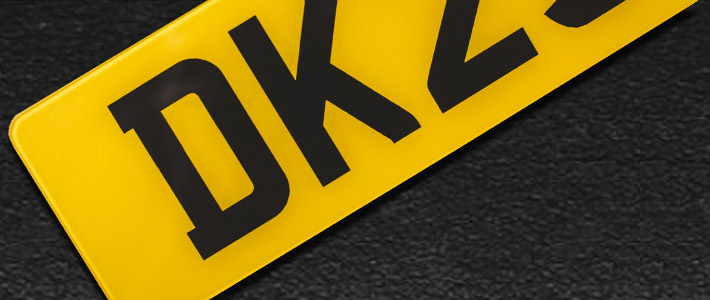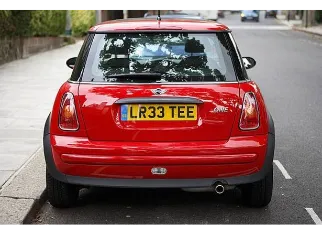All vehicles on the road in the UK are identified by their registration plates. The registration plates make it easier for local law enforcement and, of course, you as a driver of a vehicle, to keep track of whether your car is taxed in your name or not. Until the vehicle is destroyed or exported, the number plate remains with the vehicle and not with its owner.
Currently, UK number plates are subject to stringent legal requirements. If you drive while your number plates are not appropriately displayed, you might receive a fine of up to £1,000, and your car would not pass its MOT test. It’s critical to understand the regulations governing registration number plates if you drive a vehicle in the UK.
To better help you understand the rules and regulations, this article will provide details regarding UK laws governing number plate displays.
What are the UK number plate format requirements?
Depending on when your car was first registered in the UK, different registration plates have different formats. The variations consist of:
- Current Style
- Prefix
- Suffix
- Dateless (cherished)
- Northern Irish Style
In 2001, the format for car registration numbers was unveiled. To this day, it’s the same format that is being used in the UK. It includes two letters that refer to the region in the country where your vehicle was first registered, two numbers that tell you when it was issued, and three randomly chosen letters.
The first two numbers on the number plate, known as the DVLA memory tag, indicate where the vehicle was registered. A plate from Oxford might begin with the letters OA or OY, whilst one from Reading might start with RA or RY. However, these memory tags do not contain some letters (I, Q, and Z).
The age identifier is made up of two numbers. These figures are derived from a code that specifies the precise date the vehicle was registered. Since they use the final two digits of the year, all registrations from March to August may be easily calculated since the age identifies changes on March 1 and Sept. 1 every year. Here’s an example to help you better understand: if the 2 numbers on the reg plate are 08, the car was registered between March 2008 to August 2008.
Rules for Number Plates in the UK
Standards have been established for valid number plates because each plate is different, and it is crucial to have continuity for law enforcement. Here are the basic rules for UK number plates:
- Should be made from a reflective material. However, the characters must not be reflective.
- Number plates should meet the British Standard.
- Number plates should be displayed both rear and front of the vehicle.
- The front plate should display black characters on a white background.
- The rear plate should display black characters on a yellow background.
- The number plate shouldn’t have any background pattern.
- It should display the supplier of the number plate.
- It should be marked with a British Standard number.
Number Plate Dimension Rules in the UK
For Standard Vehicles number plates:
- Character Height: Group A: 89mm; Group B: 79mm
- Character Width: Group A: 64mm; Group B: 57mm
- Character Stroke: Group A: 16mm; Group B: 14mm
- Space between characters: Group A: 13mm; Group B: 11mm
- Space between groups: Group A: 38mm; Group B: 33mm
- Top, bottom, and side margins (minimum): Group A: 13mm; Group B: 11mm
- Space between vertical lines: Group A: 19mm; Group B: 9mm
For Motorcycle and Tricycle number plates:
- Character Height: 64mm
- Character Width: 44mm
- Character Stroke: 10mm
- Space between characters: 10mm
- Space between groups: 30mm
- Top, bottom, and side margins (minimum): 11mm
- Space between vertical lines: 13mm
To keep the dimensions uniform for standard vehicles, your number plate should adhere to just one group.
Rules for Getting Number Plates Made Up
A licensed and certified number plate supplier is the only place for you to get a number plate made up. Original documents proving your name, address, and authorization to use the registration number must be presented to the supplier. The following can be used to verify your name and address:
- Driving licence
- Utility, Council Tax, or rates bill from the last six months
- Bank or building society statement from the last six months
- National identity card
Rules for Displaying Euro and Other Flags on Number Plates
The option to display the European Union flag has been available since September 1, 2001. The European Union’s emblem — a circle with 12 stars on a blue background — and the national identity symbols of its member states are displayed on the Euro plate. This icon can be seen on the number plate’s very left side.
When travelling within the European Union, vehicles without the conventional oval-shaped national identity sticker are no longer required to display this Euro sign on their number plates. By international agreement, the distinguishing Great Britain sign is on all vehicles registered in England, Northern Ireland, Scotland, and Wales.
Since Brexit, number plates are no longer printed with the EU tag. This came into force in January 2021.
Displaying the Registration Number
Once your request to utilise the registration number has been granted, you’ll need proof that you’re authorised to display the registration number before driving with your number plate. Bring one of the following to show your authorisation to display the registration number:
- Vehicle registration certificate, which can be V5C or V5CNI
- A green new keeper slip from the registration certificate
- Certificate of entitlement to the number plates
- Retention document (V778)
- Renewal reminder for vehicle tax or SORN (V11 or V11NI)
- Temporary registration certificate (V379 or V379NI)
- A number plate authorisation certificate with an official stamp from the Driver and Vehicle Licensing Agency (DVLA)
- Electronic number plate authorisation certificate
- A letter of authorisation from a fleet operator indicating the document reference number from the registration certificate
- A PDF of the vehicle’s details from the view vehicle record service
- UK trailer registration certificate (VTRC)
Bottom Line
The rules and regulations governing number plates can at first seem a little complex, but violating them could result in several penalties. This guide will guarantee you have valid registration plates. Always bear in mind that if you decide to get a personalised or customised number plate, be smart and responsible about it by selecting from the options offered on the Driver and Vehicle Licensing Agency’s official website and reading up on the UK number plate regulations.



